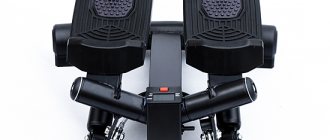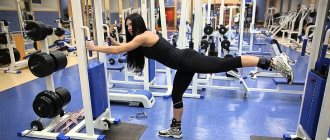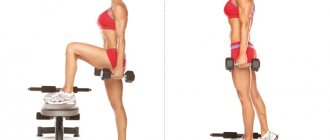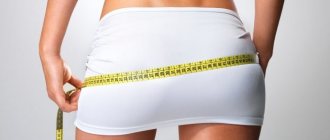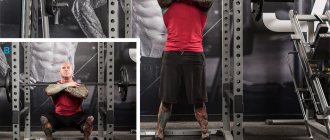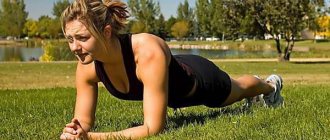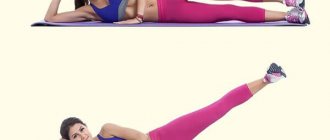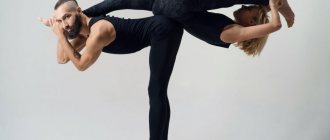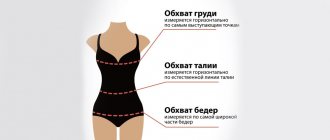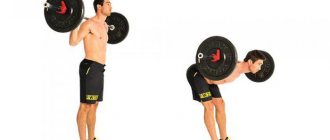Training program for men and women
Correct mistake
Buttocks
are the most attractive part of the human body. As psychologists have established, men primarily evaluate their buttocks and chest, while girls are intuitively interested in the width of their shoulders and the volume of their buttocks.
According to anthropologists, the buttocks are one of the main factors of attractiveness for both men and women because they reflect a person's ability to run long distances, which was an important evolutionary factor for survival.
A 2020 study conducted by a team of scientists from King's College London found that developing leg strength will improve brain function as you age.
In a 2020 study, British scientists concluded that larger buttocks have a positive effect on the health and intelligence of women due to the high content of omega-3 fatty acids in the lower body.
additional approaches must be used.
(in order of importance).
If you are overweight:
If you have a thin build:
Anatomy of the buttocks and pelvis
Anatomy of the gluteal muscles: side viewAnatomy of the gluteal muscles
To choose the right exercises for the buttocks, you need to know their anatomy and morphological features well.
Women's pelvis naturally has a slightly greater forward tilt than men's, which increases the lumbar lordosis of the spine and emphasizes the convexity of the buttocks. Poor posture and weakened hamstrings also cause the buttocks to appear disproportionately large.
The buttocks are formed by three main muscles:
- The gluteus maximus
is the largest and most prominent of the gluteal muscles. It has a diamond shape and is located above all other gluteal muscles; it plays a large role in fixing the torso and hip extension. - The gluteus medius
is a small muscle that sits laterally on top of the gluteus maximus. It is visible when viewed from the side or behind. The gluteus medius muscle works in hip abduction and in exercises that involve the pelvic area; its anterior bundles are involved in inward rotation of the thigh, and its posterior bundles are involved in movements where the thigh rotates outward. - The gluteus minimus
is a small muscle located laterally under the gluteus maximus and is therefore not visible at all. The function of the gluteus minimus muscle is similar to that of the gluteus medius. The gluteus minimus muscle is worked during leg movements and all movements that involve the pelvic area and torso.
The glutes support the hamstrings when you need to increase your speed. When you walk slowly they barely work. But when you speed up and start running, your buttocks are actively involved in the work.
The gluteal muscles help the quadriceps to extend and rotate the thigh outward, and together with the muscles of the back of the thighs, they extend the torso from a tilted position. In addition, they tilt the body to the side.
Helpful advice
Lack of mass in the gluteal muscles automatically means their weakness, and with it low results in all leg exercises, from squats to jumping and running.
If you sink into squats with a barbell on your shoulders, but cannot get up, this suggests that you should equally increase the strength of your quadriceps and buttocks. Leaving the glutes alone means reducing the lifting force by almost half.
Shapes of female buttocks: 1. Inverted “V”; 2. Square; 3. Round; 4. “Heart” An easy way to instantly “pump up” your buttocks
Basic exercises for pumping up the buttocks
The gluteus maximus muscles are well worked when performing basic leg exercises - squats, lunges and deadlifts.
But for the medium and small bundles of the gluteal muscles, you need to perform special exercises - swinging your legs in a block device, or with leg weights.
To fully work out the “minor” muscles of the gluteal region, you need to perform these exercises both in a standing position and lying on your side.
Exercises for the gluteus maximus muscle
Exercises for the gluteus medius and minimus muscles
Read more:
Exercises for buttocks and legs
Features of buttock training
The shape of the buttocks depends on heredity. However, with the help of exercises they can be made more toned, strong and elastic. Plus, having strong glutes will not only make you look amazing in skinny jeans, but will also help you noticeably improve your running and jumping performance. To do this, in addition to the gluteal muscles, you need to train the spinal erector muscles and the muscles of the back of the thighs.
The best exercises for the buttocks are squats, lunges and deadlifts. It is best to train your buttocks on the same day as your legs, since by doing squats you will stress both the leg muscles and the buttocks equally. To ensure that your gluteal muscles receive maximum load, squat as low as possible. When performing lunges, you need to take a wider step, since with a narrow step the load will shift to the quadriceps.
Train your buttocks and legs once a week, performing 2-3 exercises in 3-4 sets (depending on your training). The number of repetitions in each approach is 8-12. Follow these simple recommendations and exercise your buttocks regularly to always be in good shape, not only in the front, but also in the back.
Hottentots
All men have long noticed that some women of African descent have more developed gluteal muscles than European women of any nationality. This trait is very ancient from an evolutionary point of view. Professor Alik Huseynov from the Anthropological Institute and Museum in Zurich, Switzerland, based on his discoveries, believes that all women who lived in the Upper Paleolithic era in Europe had such butts. Just a few years ago, ceramic figurines and colored rock paintings depicting priestesses of local tribes were found in caves in southern France and Austria, at excavated sites of ancient people. These women are presented with huge buttocks, located at an angle of 90 degrees relative to their backs. Moreover, the priestesses’ skin color is not black or white, but rather yellow, close to the shade of withered autumn foliage. It can be assumed that over tens of thousands of years the color scheme of rock paintings and ancient ceramics faded or changed in some other way, but Professor Khuseynov does not think so. He points out the exact similarity of the depicted priestesses with women of some modern South African peoples, for example, the Hottentots. This tribe still inhabits the English colony of the Cape of Good Hope, and this nation received its name back in the 18th century from Dutch settlers. The origin of the Hottentots is unknown, but their type is a combination of the characteristics of the black and yellow races, which is why, despite obvious Negroid differences on their faces, they have yellowish-red-brown skin. But the Hottentots also have other incredible features - an original language with strange, clicking sounds (which, according to some ethnographers, was characteristic of Neanderthals) and incredible steatopygia in women, that is, the presence of giant gluteal muscles and, in this case, located relative to the back just at an angle of 90 degrees. Professor Huseynov suggests that for some biological reasons, the Hottentots in the extreme south of Africa survived, while in Europe, millennia of evolution transformed the same type of people into the modern European species.
Types of exercises
There are two general groups of exercises for the gluteal muscle:
- With or without weights.
- Basic or isolated.
When performing exercises, the main thing is not to forget about the execution technique. If it is violated, instead of the gluteus maximus muscle, you risk increasing the volume of the quadriceps muscle. But even more serious consequences of incorrect exercises are disruptions in the functioning of the joints, which can lead to injuries to the gluteus medius muscle.
Dumbbells and barbells serve as weights. The weight and type of weighting depends on the training level of the trainee. When working with them, the technique should not be disrupted, and the muscles should be felt working.
The basis of any training aimed at correcting the gluteus maximus muscle should be basic exercises. The most effective ones are lunges, squats, split squats and deadlifts.
Squats are one of the most effective and difficult exercises in terms of technique. To master it, you need a weighting device of the smallest weight (for example, a bar without a load).
Deadlifts can be performed with heavier weights and help improve the appearance of the gluteal region since even the gluteus minimus will be engaged.
When working on the muscles of the pelvic area, you can use not only weights, but also various exercise equipment and auxiliary items. A split squat is a lunge with the non-working leg placed on a bench.
For more detailed, targeted correction of the muscles of the buttocks, so-called isolated exercises are used. They are performed after the basic ones. These include: lifting the pelvis, pressing, abducting the legs to the side.
Gluteus major
“Even ugly buttocks do not interfere with a person’s movement. We could do without the main muscle in this area – the gluteus maximus – says Makarova. — She is responsible for the correct vertical posture when walking
, but the human body is designed in such a way that its weakness or absence is compensated by other muscles.”
True, in this case the load will be taken on by the muscles of the lumbar back, which can be injured from overexertion. So the habit of keeping the gluteus maximus muscle toned is a good way to avoid back pain
.
The gluteus maximus muscle extends the thigh at the hip joint, but the range of this movement is very small - only 5-10 degrees. The main exercises that help strengthen the gluteal muscle are hip extensions.
Anatomy
The largest muscle is the gluteus maximus. It is located closest to the skin and is responsible for the appearance and aesthetics of the buttocks, since it determines how much this part of the body will protrude. Its structure is diamond-shaped, wide and fleshy.
The abnormally large size of the muscle tissue of the buttocks is a characteristic feature of the structure of the muscles of people, and it is this that allows a person to hold his torso straight upright. Structurally, a large muscle consists of coarse fibers that are collected in bundles and are parallel to each other. These bundles are connected into one large one, but at the same time they are separated by partitions consisting of fibers.
The gluteus maximus muscle originates in the area of the ilium (specifically the back of it) and is located directly above and behind the iliac crest. It then runs along the lower part of the sacrum away from the coccyx. The fibers are directed downward and sideways, forming with the external fibers most of the muscle in its lower part. Next, the muscle bypasses the greater trochanter of the femur and turns into a wide shell. The deep-seated fibers in the lower part of the muscle are located between the vastus lateralis and adductor muscles.
The gluteus maximus muscle is one of the main muscles used in sports such as hockey, basketball, football or volleyball. Its stretching can be very painful and take a long time to resolve.
Medium and small muscles
In humans, the gluteal fibers are quite well developed. The abnormally large size of this group allows the body to be held in an upright position. The middle muscle begins on the outer part of the ilium. The beginning is the gluteal aponeurosis. The fibers end in the form of a tendon, which is attached to the side of the hip joint. The minimus muscle begins between the lower and anterior parts of the gluteal line from the ilium. The small fibers in the posterior part pass from the ischial muscle and attach to the hip joint.
